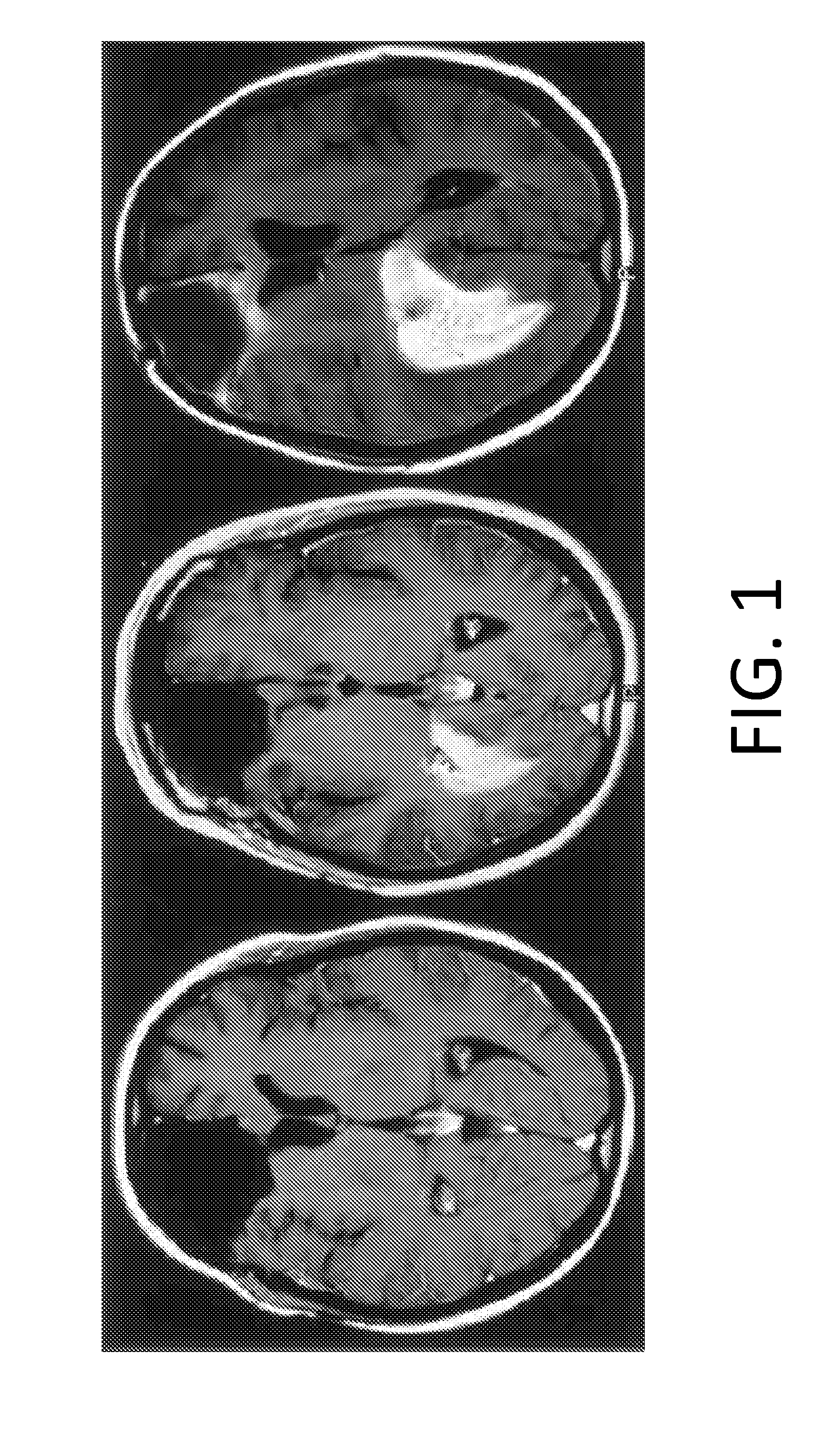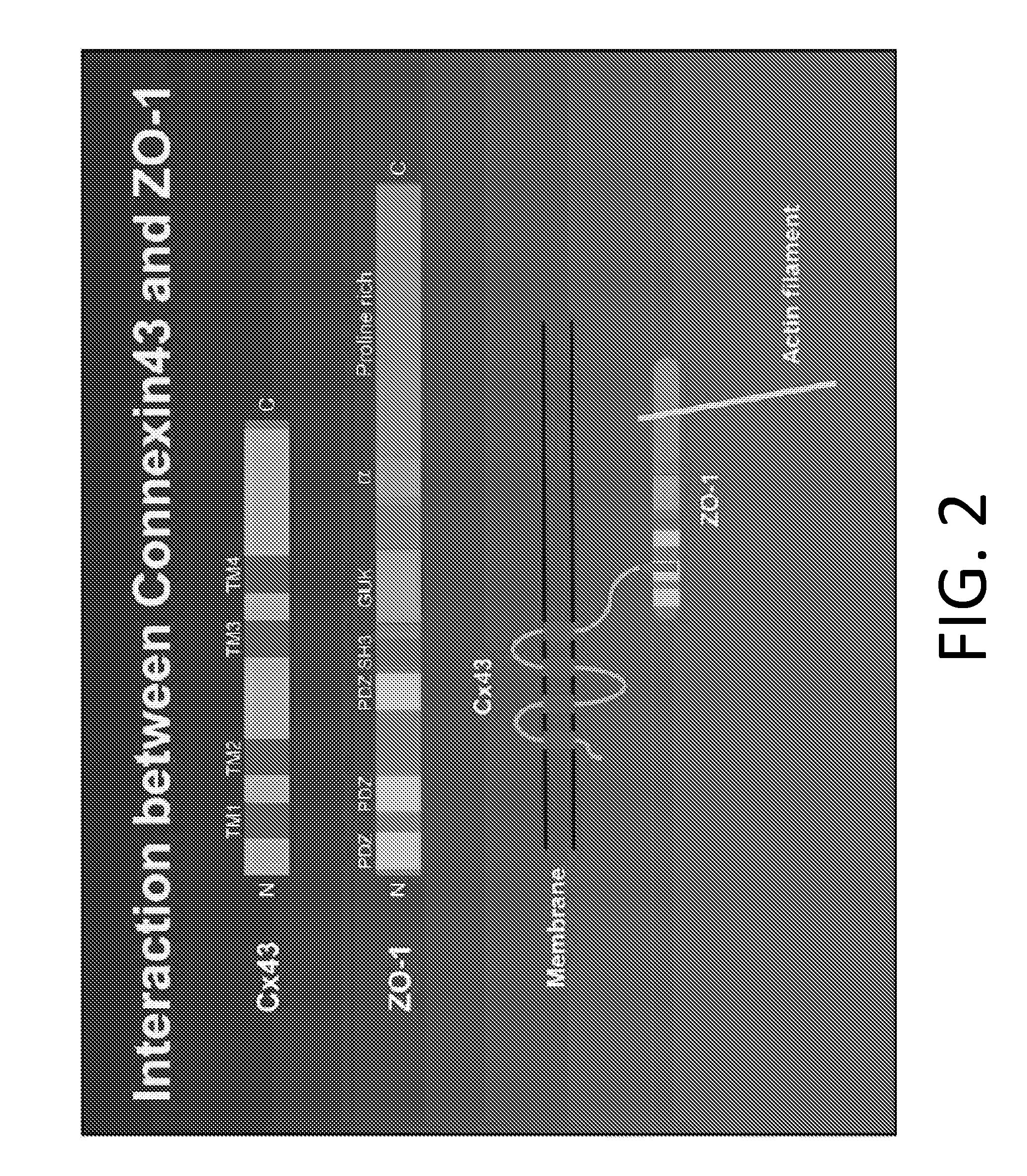Methods of treating a cancer through targeted disruption of alpha connexin 43-zonula occludens-1 (zo-1) interaction
a technology of zonula occludens and alpha connexin 43, which is applied in the field of cancer treatment, can solve the problems of extremely difficult disease to trea
- Summary
- Abstract
- Description
- Claims
- Application Information
AI Technical Summary
Benefits of technology
Problems solved by technology
Method used
Image
Examples
example 1
[0259]Unphosphorylated biotinylated AAP10 (500-1 ng) shows concentration dependent affinity for the Cx43 CT domain in a dot blot (FIG. 5). By contrast, the tyrosine phosphorylated isoform biotinylated AAP10-pTyr show no affinity for Cx43 CT.
[0260]FIG. 6 is an image of a polyacrylamide gel showing EDAC cross-linking reaction of ACT-1 and connectin 43 carboxy terminal peptide. ACT-1, but not inactive control peptide interacts with the Cx43 CT. ACT-1 is shown by the zero order cross-linker EDAC. ACT-1 binding to Cx43 CT reduces Cx43 CT homodimers.
example 2
[0261]UM87MG glioma cells, which express Cx43, were cultured in serum-free conditions permissive to aggregation. The cells were treated with the ACT-1 peptide for 48 hours and then imaged with phase-contrast microscopy. It can be observed that cells treated with ACT-1 at a concentration of 25 μM tended to form amorphous clumps (FIG. 7C) that were not as prevalent in untreated cultures (FIG. 7A) or in those treated with a control peptide (FIG. 7B), which has the ACT-1 amino acid sequence in reverse order. To quantitate the extent of aggregation, ImageJ software was used to collect size information about the aggregates in these images and from that information an aggregation index was calculated for each image. The AI is defined as the total area of aggregation in a field divided by the number of single, unaggregated cells in that field. So an increase in the ratio of aggregation area to unaggregated cells would increase the AI and indicate a higher propensity to aggregate. The AI cal...
example 3
[0263]After an overnight peptide pre-treatment in 10% serum, two glioma cell lines, c6 and U87, were seeded in serum-free media containing peptides into Boyden chamber transwell inserts with 8 μm pores in the membrane and then filled the bottom wells with media containing 10% FBS as a chemoattractant. After a 4 hour incubation period, the cells that did not migrate through the membrane were scrapped off. Then the migrated cells were fixed, stained with Hoescht dye, and imaged on an epifluorescence microscope. The nuclei in the images of each treatment group were then counted, and in U87 cultures treated with the ACT-1 peptide (FIG. 9C), there was a significant decrease in cell migration across the Boyden chamber membrane compared to no treatment (FIG. 9A) and control peptide treatment (FIG. 9B), indicating a lesser degree of motility in ACT-1 treated cells (also shown in the graph in FIG. 9D, which compares no treatment and four treatments (1 μM ACT-1, 25 μM ACT-1, 1 μM Reverse (Con...
PUM
| Property | Measurement | Unit |
|---|---|---|
| Fraction | aaaaa | aaaaa |
| Fraction | aaaaa | aaaaa |
| Length | aaaaa | aaaaa |
Abstract
Description
Claims
Application Information
 Login to View More
Login to View More - R&D
- Intellectual Property
- Life Sciences
- Materials
- Tech Scout
- Unparalleled Data Quality
- Higher Quality Content
- 60% Fewer Hallucinations
Browse by: Latest US Patents, China's latest patents, Technical Efficacy Thesaurus, Application Domain, Technology Topic, Popular Technical Reports.
© 2025 PatSnap. All rights reserved.Legal|Privacy policy|Modern Slavery Act Transparency Statement|Sitemap|About US| Contact US: help@patsnap.com



